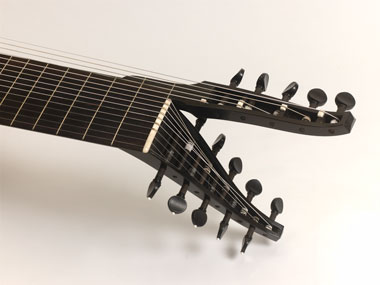Current models
Particular forms of pegbox
Somebody always asks after lute concerts why the pegbox is bent back.
The answer remains: we don’t know.

We are a little better informed, however, concerning the profound effects of an elongated, “theorboed”, neck on the frequency proportions of the whole instrument, not merely on the longer bass strings.
The lengthening of bass strings, appearing around 1600 and attributed to Alessandro Piccinini, was primarily intended to increase the sound of the bass register, making it more “like an organ”. The discovery that a straight pegbox with high tension, lengthened bass strings can also positively influence the descant and middle range of a lute instrument may have been an unexpected side effect of this invention.
The classic form of the “swan neck” which one finds on Italian archlutes and theorbos has great aesthetic charm and admirably fulfils its sonic purpose as well.
Inspired by this innovation further kinds of lengthening were developed during the 17th century, culminating in the French baroque lute tuned to d minor. In historical sequence, it concerned on the following construction.
- The lateral extension on a bent-back pegbox for fitting four additional bass courses of different lengths (double head), invented by Jacques Gaultier (born circa 1600), a French lutenist resident in England (see picture above).
- Bracket or bass rider for two additional longer bass courses, presumably attributable to the Bohemian lutenist Jan Antonin Losy (c.1645-1721).
- The adaptation of two straight pegboxes from the neck of the angélique, adopted for his 13 course d minor lute by Sylvius Leopold Weiss, most probably at the suggestion of J. S. Bach (see: Models/Instruments with Double Courses, Liuto forte in d).
This latter construction, wherein eight courses were on the fingerboard and five drone were in the second, extended pegbox, was the climax in the developemant of the European lute.
Depending on whether you would prefer a bass register as voluminous as possible, or one with much less sustain, or rather one in between these extremes, then the third, second or first, respectively, of the lengthened bass string variations here described may be your best choice. Besides acoustical criteria, practical and aesthetic considerations will normally influence a decision.



